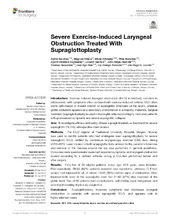Severe exercise-induced laryngeal obstruction treated with supraglottoplasty
Sandnes, Astrid; Hilland, Magnus; Vollsæter, Maria; Andersen, Tiina Maarit; Engesæter, Ingvild Øvstebø; Sandvik, Lorentz; Heimdal, John-Helge; Halvorsen, Thomas; Eide, Geir Egil; Røksund, Ola Drange; Clemm, Hege Synnøve Havstad
Peer reviewed, Journal article
Published version

Åpne
Permanent lenke
https://hdl.handle.net/1956/22719Utgivelsesdato
2019-07-31Metadata
Vis full innførselSamlinger
Sammendrag
Introduction: Exercise induced laryngeal obstruction (EILO) is relatively common in adolescents, with symptoms often confused with exercise induced asthma. EILO often starts with medial or inward rotation of supraglottic structures of the larynx, whereas glottic adduction appears as a secondary phenomenon in a majority. Therefore, surgical treatment (supraglottoplasty) is used in thoroughly selected and highly motivated patients with pronounced symptoms and severe supraglottic collapse. Aim: To investigate efficacy and safety of laser supraglottoplasty as treatment for severe supraglottic EILO by retrospective chart reviews. Methods: The EILO register at Haukeland University Hospital, Bergen, Norway was used to identify patients who had undergone laser supraglottoplasty for severe supraglottic EILO, verified by continuous laryngoscopy exercise (CLE) test, during 2013–2015. Laser incision in both aryepiglottic folds anterior to the cuneiform tubercles and removal of the mucosa around the top was performed in general anesthesia. Outcomes were questionnaire based self-reported symptoms, and laryngeal obstruction scored according to a defined scheme during a CLE-test performed before and after surgery. Results: Forty-five of 65 eligible patients, mean age 15.9 years, were included. Post-operatively, 38/45 (84%) patients reported less symptoms, whereas CLE-test scores had improved in all, of whom 16/45 (36%) had no signs of obstruction. Most improvements were at the supraglottic level, but 21/45 (47%) also improved at the glottic level. Two of 65 patients had complications; self-limiting vocal fold paresis and scarring/shortening of plica ary-epiglottica. Conclusion: Supraglottoplasty improves symptoms and decreases laryngeal obstruction in patients with severe supraglottic EILO, and appears safe in highly selected cases.
